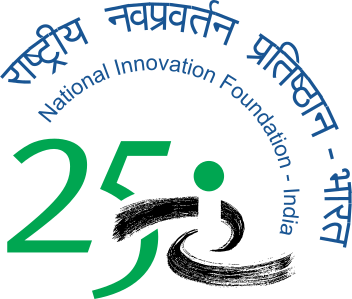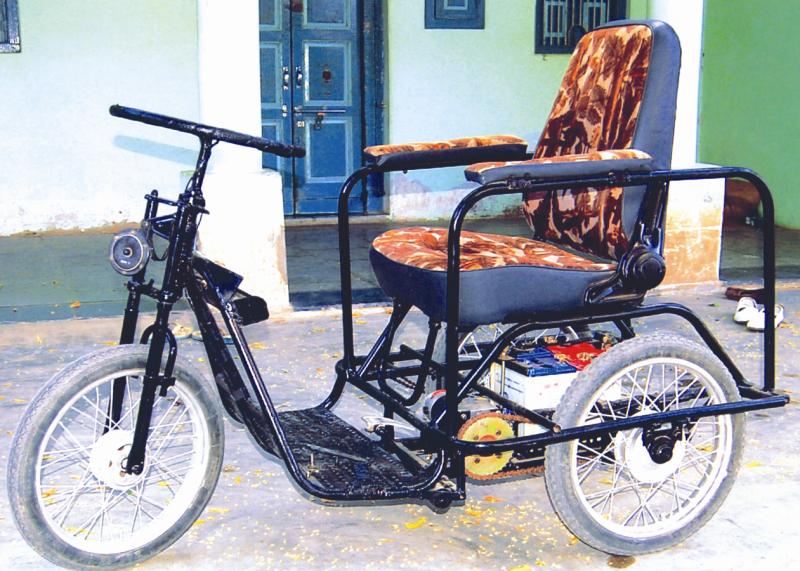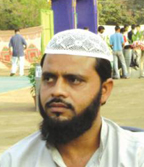The inspiration behind the vehicle
His father, Ibrahimbhai suffered a paralysis attack in 2001, which left the right side of his body benumbed. He had to be supported at all times and could not move himself. The doctors had advised him some rehabilitation exercises for improvement. Asjadbhai was moved by his father’s condition. He thought of developing a bed, which could give him support while sitting. He also though of incorporating a provision of a table for taking food and a small exercising machine for doing the exercise. Almost within a month, with some effort, he made the bed to bring some respite to his bedridden father.
Gradually, his father’s condition began to improve but largely he was confined to his room. It was then Asjadbhai thought to purchase a tricycle so that his father could move around. He explored the market to find a suitable one but could not find any. So, he started making a tricycle to suit the needs of his father himself.
He took the tricycle of his grand father as the base model and starting incorporating changes piece by piece. First, he replaced the wheels with those of Kinetic Luna. He thought of using its motor also but considering the fact it may be not possible for a paralysed person to control it, he dropped the idea. Then the idea to use a motor driven by battery occurred to him but he was not sure about which one exactly to be used. One of his friend suggested using a DC motor so that the speed could also be altered as per the need. He procured such a motor from Alang, Bhavnagar.
His attention then focused on the acceleration and braking section of the tricycle. His idea was to keep the operation simple so that his father did not have to operate many levers. He thought of providing accelerator and brake on the same lever but inspite of persistent attempts, he could not succeed. Hence instead, he put the brake lever besides the accelerator.
While he was developing the tricycle he faced a lot of problems. The lack of technical know-how was one along with the unavailability of willing fabricators. As this machine was being made part by part, no many from among the pool of handful of fabricators were willing to work on the design and complete it. However, through polite persuasion Asjadbhai could get his work done/
When the tricycle was about to be completed in 2004, he started training his father so that he could ride it without any much ado later. He tried to teach him with sticks and other props so that he got used to them before trying his hand at the three-wheeler, which was more challenging. Once he was confident that his father would be able to handle the three-wheeler he brought it to him. In few weeks’ time he got acquainted with the tricycle.
When the news about his innovation spread across the area, product queries started pouring in. Local media also covered the story many times. He fabricated and sold four such three-wheelers for other people who needed such a vehicle for their personal use.
The battery operated tricycle
The innovation is a battery operated multi-featured tricycle with a steering wheel possessing better ergonomics and flexibility. It has been customized to suit the requirements of the differently abled user in a very simple manner.
The tricycle operates on a battery & DC Motor (24V, 21 W, 1.5A). The battery allows the vehicle to run for 8 hours after full charge. The motors give a uniform speed of 8 km/hour facilitating its movement on sand also. Asjadbhai has incorporated few other features also. It has a reverse brake system, which allows this tricycle to move forward only. Hence, the tricycle can run on incline also without any fear of moving backwards, down the slope.
Ergonomics have been carefully considered. The side metal arm support can be lifted allowing the disabled person climb up the seat comfortably. Once the person gets seated, the same can be lowered and locked. The seat has a push back system so that when the user feels tired he can push it back and extend it like a bed and take rest. Up to three hundred kg weight can be carried on his vehicle. The vehicle, which has a headlight, also has a provision of a water bottle holder and a news paper/magazine holder.
Though there are other tricycles available but the innovativeness in the present one is the integration of simple solutions making the tricycle disabled friendly.
Other innovative pursuits
In 1997-98, the year when his younger daughter Rubina was born, Asjadbhai noticed that a person was always needed for constantly moving the swing while she was sleeping. In order to automise the process, he coupled parts of the sewing machine with a small motor. This he attached to the traditional swing. Whenever there was a need to move the swing, only a button was now needed to be pressed. The only shortcoming was that the motion was a bit jerky and not as smooth as when moving with hand.
Modified pulverization unit for poultry farms
The manual poultry pulveriser requires higher human power and time for pulverizing the excreta of the hens and mud at the poultry farm. The excreta of the hen and the mud get hard as the layers deposited one over the other. The poultry farm floor has to be cleaned regularly by taking out the old mud and layering fresh mud so that the poultry does not catch any infection. The old mud can be used as the manure for farming. In the year 2003, Asjadbhai modified the pulverization equipment by incorporating a prime mover and a drive to it so that output higher than manual work can be achieved.
Customised minarets for mosques
Presently, minarets are built on site using bricks and cement as the binder. As everything is done manually, there are chances or errors in duplicating the design. More time is also required for the completion of the task, specifically for the tall minarets. To take care of all these problems, Aszadbhai has recently the developed a RCC hollow concrete structure to build the minarets. Presently, he makes the minarets in seven designs, ranging from a height of seven feet to 30 feet. As per the design and height selection, the individual building blocks are made off site and are transported on site where they just have to be put on top of each other and joined, which is followed by the filling of cement-concrete mixture inside it. This reduces the cost and time of building the minarets. Asjadbhai mentions that using this technique, a single 30 feet minaret can be completely constructed in 4-5 days spending only about Rs. 60000. This process also does not require skilled labors to build minarets. His team does the installation on site. He has build eight minarets all over India using the same hollow concrete structure.
Asjadbhai also participated in ‘Saatvik’ - the Traditional Food Festival in 2008 at IIM, Ahmedabad. He also displayed his technology at the Blind People Association, Ahmedabad, which showed interest in his tricycle and also suggested certain changes. Accordingly GIAN has engaged a local designer and fabricator, for the fabrication of this tricycle. He also received SRISTI Samman in 2008 for his efforts to make this user friendly customized tricycle. A patent has also been filed by GIAN-NIF for the same in the name of Asjadbhai. GIAN- NIF has also submitted a proposal to TePP DSIR for further value addition work in the tricycle. He has now designed a battery operated tricycle that can be operated using a single hand.
Failing to find a comfortable ride for his paralytic father, and pained by his helplessness, Asjadbhai Dhucca (35) developed a customized tricycle for him. This tricycle has many features that make its ride easy and comfortable for the differently abled.
Born in 1974 to Ibrahimbhai and Hamidaben, Asjadbhai is the third eldest among five siblings. His father was a farmer. An average student, he opted to study commerce in class twelve after passing class ten. He was a good painter and his painting of the Taj Mahal had won him a prize when he was in class ten. After class twelve he joined college but as he was weak in English, he could not cope up and to leave studies. He then started helping his family in agriculture and poultry farming, which was started by his elder brother.
Complete Specification Filed , 2570/MUM/2009








